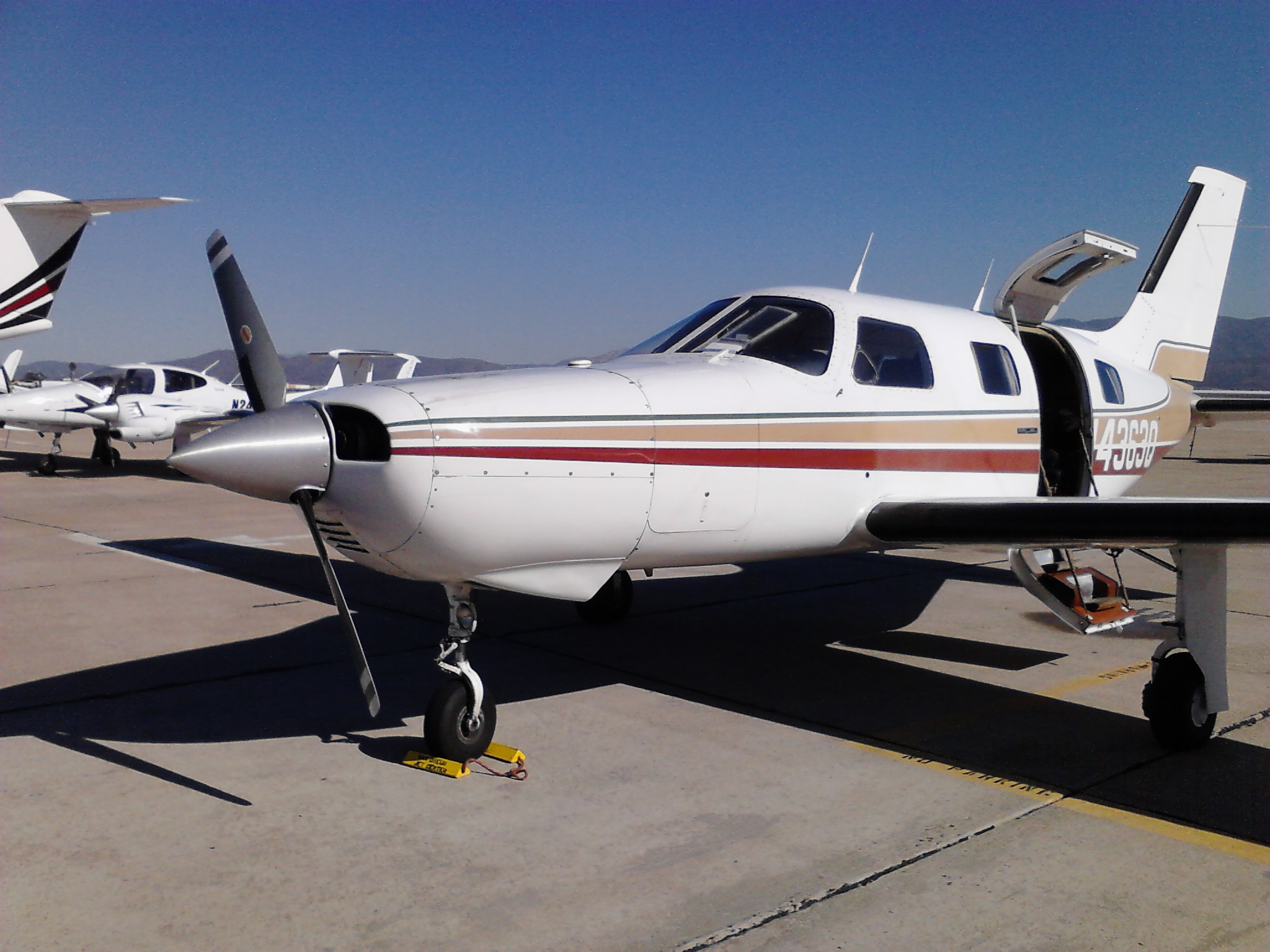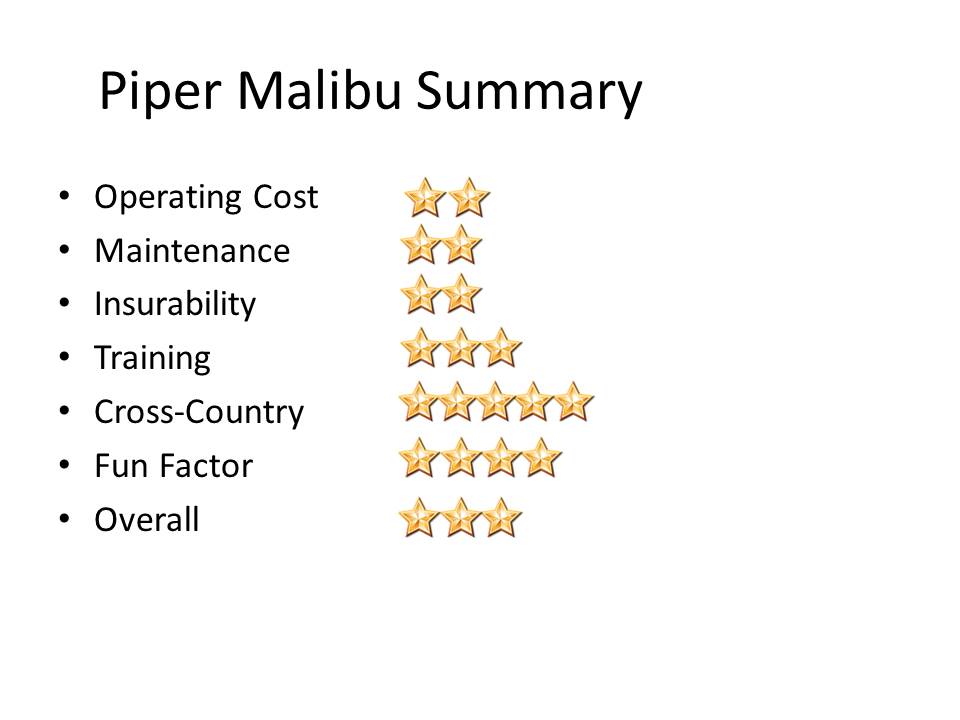 The Aircraft Spotlight feature looks at an airplane type and evaluates it across six areas of particular interest to flying clubs and their members: Operating Cost, Maintenance, Insurability, Training, Cross-Country, and Fun Factor.
The Aircraft Spotlight feature looks at an airplane type and evaluates it across six areas of particular interest to flying clubs and their members: Operating Cost, Maintenance, Insurability, Training, Cross-Country, and Fun Factor.
If you want to fly high and fast, Plus One Flyers based at four airports near San Diego California, has the airplane for you – the Piper Malibu. Its high operating costs and the additional training needed to fly the airplane definitely make it a luxury for most clubs, but it’s an easy step up from other Piper products for those who want to fly at higher flight levels. With a pressurized cabin and the ability to get above the weather, the Piper Malibu will get where you’re going in style. It is the only one operated by a club in the U.S. and Dave Eby, Plus One’s Manager of Monterrey (MYF) and Gillespie (SEE) operations, shares his club’s experience.

Operating Cost (2 stars)
It’s an expensive airplane, but it’s not outrageous. The rental rate is $299 an hour, Hobbs time wet. Fuel burn averages 22 gph—32 gph in climb and about 16 gph in cruise, which is why it is popular. “You can lean this bad boy out and get some leg out of her,” Dave said. “Sixteen gph cruise is worth paying this dividend.”
Plus One’s Malibu was built in 1984, the first year it was produced. The low fuel burn at cruise is because the Continental engine is operated 50 degrees lean of peak, otherwise the cylinders will melt, Dave said.
Its utilization varies. Some months it flies 40 or 50 hours and others it might not fly 10. “It either flies like crazy or sits on the ground. It’s hot or cold,” Dave said.
Maintenance (2 stars)
It’s a complex airplane with a pressurization system, which means it can be expensive to work on. “An average annual is $3,000 to $5,000 if they don’t find anything wrong,” Dave said. “And if they do, it probably goes up by a factor of five.” For example, they just spent $30,000 to replace the rear windows. However, Dave said Malibus are really solid, straight-forward airplanes and there aren’t any surprises from a maintenance standpoint.
Insurability (2 stars)
Getting a Malibu insured would be difficult for most clubs. If an insurer is willing to take it on, it will be expensive. Plus One operates 67 aircraft and has 1,200 members, so it was able to get coverage, in part because of its good relationship with its insurance company, Chartis. But Dave said he’s not sure if he could get another one insured.
The aircraft is valued at $250,000 and the premium is a little more than $600 a month. However, it was a lot more when Plus One first put the aircraft into the fleet eight years ago. The club also has a self-insurance program that it uses to pay for minor incidents, which helps reduce claims and insurance rates.
Training (3 stars)
The only training that will be done in the Malibu is to get checked out in the airplane and learn how to fly at high altitudes. To get checked out, Plus One requires 500 hours total time, 100 hours complex, a current IFR rating and if you don’t have Malibu time, 10 hours dual in make and model with a designee. That’s about a $4,000 investment. “Some will cringe at it, but the people who are serious that want to fly it will pay the money,” Dave said.
“Training is key. A lot of bad things can happen really fast at two-five-zero,” Dave said. Most of the guys are stepping up from 182s or 210s. Training includes upper air work, slow flight, emergency descents, emergency gear extension, and teaching the complex systems, as well as takeoffs and landings with full flaps and no flaps. On the last training flight, Dave takes pilots up to 21,000 or 22,000 feet to get used to the transition altitude at 18,000 feet and to experience the Jetstream.
“It’s probably one of the easiest flying planes in the club. It’s almost benign. It’s a really stable airplane,” he said. However, it does have a very low maneuvering speed.
Cross Country Travel (5 stars)
This is what the Malibu was designed for. It can get up above the weather and into the Jetstream and has a cruising speed of 195 knots TAS at 25,000 feet, Dave said. Its 120-gallon tanks give it a range of 900-1,000 miles. The only negative — you really can’t put a load in it. “You’re not taking 6 people with full tanks” Dave said. “There is a trade off.”
Members taking the aircraft are usually flying longer distances—to places like Alaska, Canada, Boston, and Texas. The club has a 1-hour per day daily minimum.
This aircraft is equipped for flight into known ice (FIKI) with boots and a heated windshield giving members a little more versatility if they encounter weather.
Fun Factor (4 stars)
“It’s definitely a fun airplane to fly – it’s so benign. It’s so comfortable. Once you get going, it’s wow, here we are,” Dave said. “That’s the number one thing. When we fly, people say, wow, we’re really moving.”
The other benefit is that it’s pressurized. Whether you’re flying at 10,000 feet or 25,000 feet the pressurization pays dividends. When you get to your destination you feel a lot better than if you were in a non-pressurized aircraft.
Overall (3 stars)
It’s a unique airplane and only a club with a particular niche is likely to have the market for one. “Realistically in the eyes of a club, it’s kind of crazy to have,” Dave said. It works for Plus One because of the club’s size and the marketability and the value that the aircraft provides. For a club with experienced pilots who are looking for a fast, comfortable cross-country aircraft and can afford it, the Piper Malibu is certainly a nice way to fly.